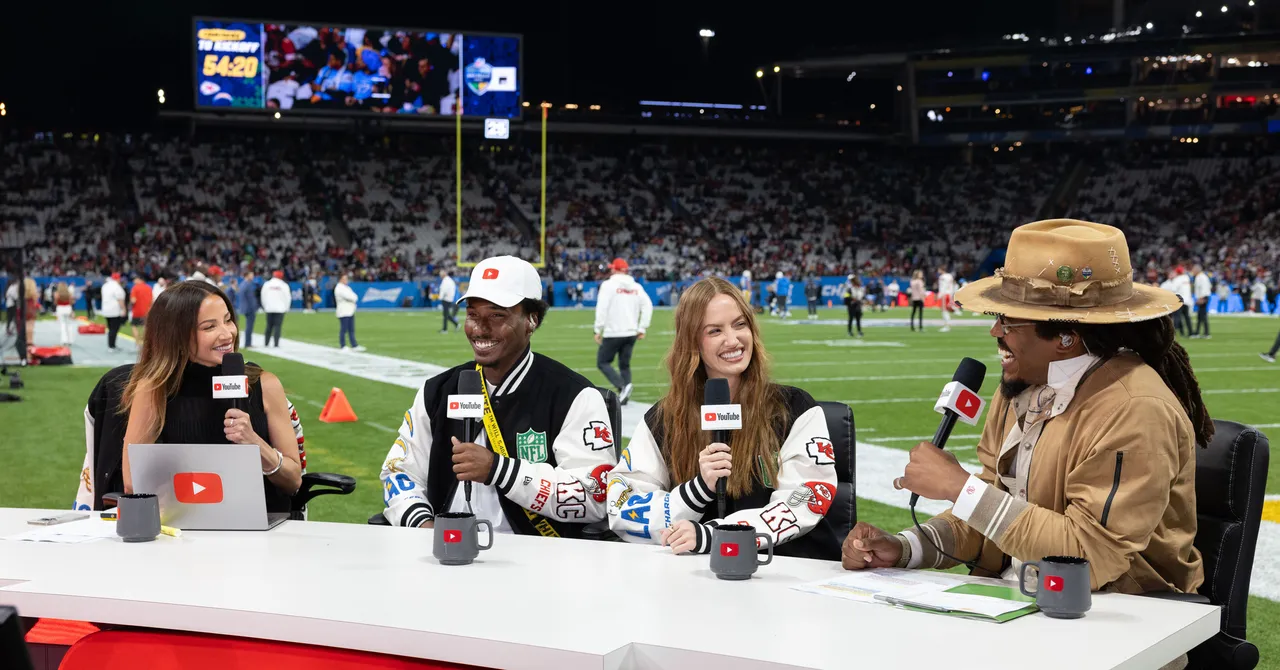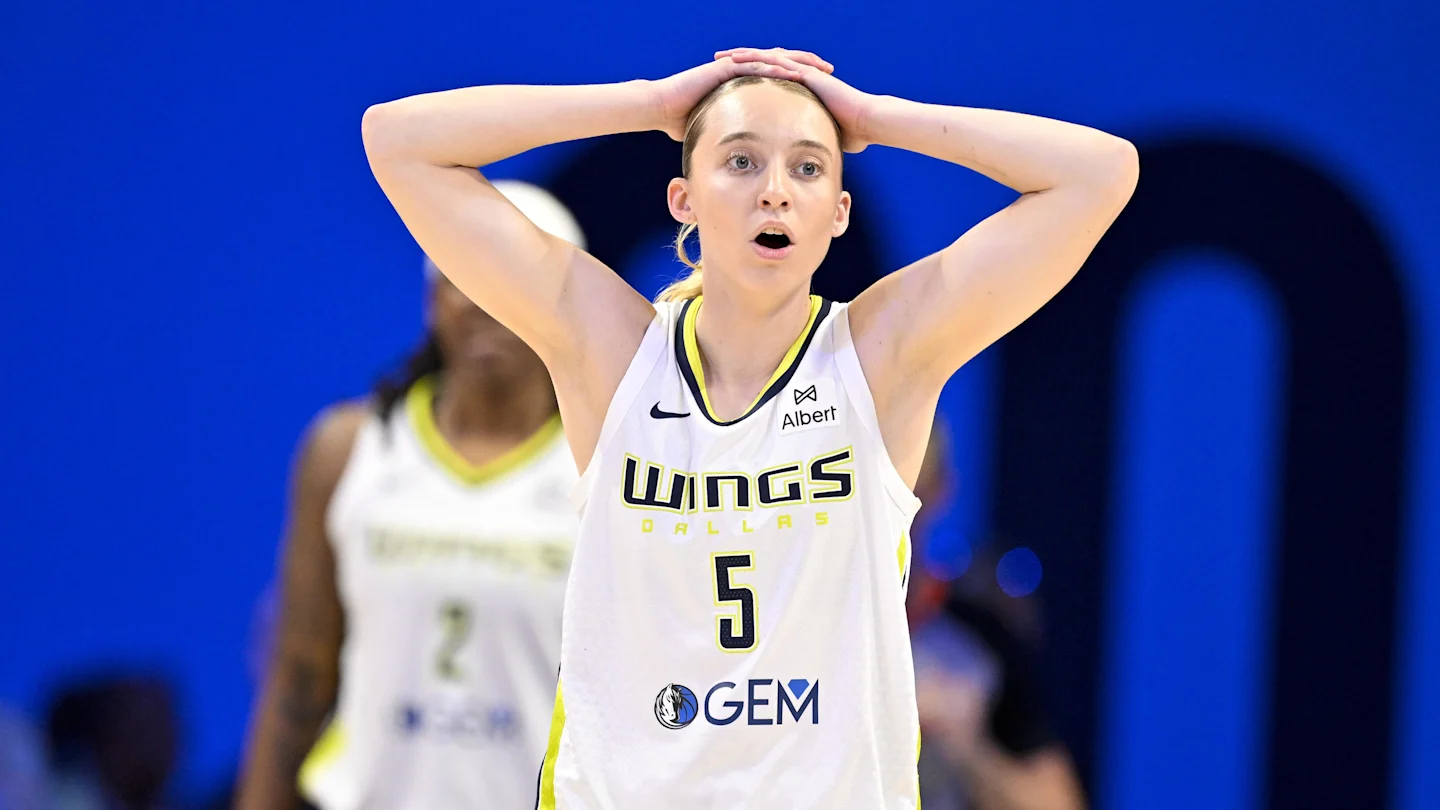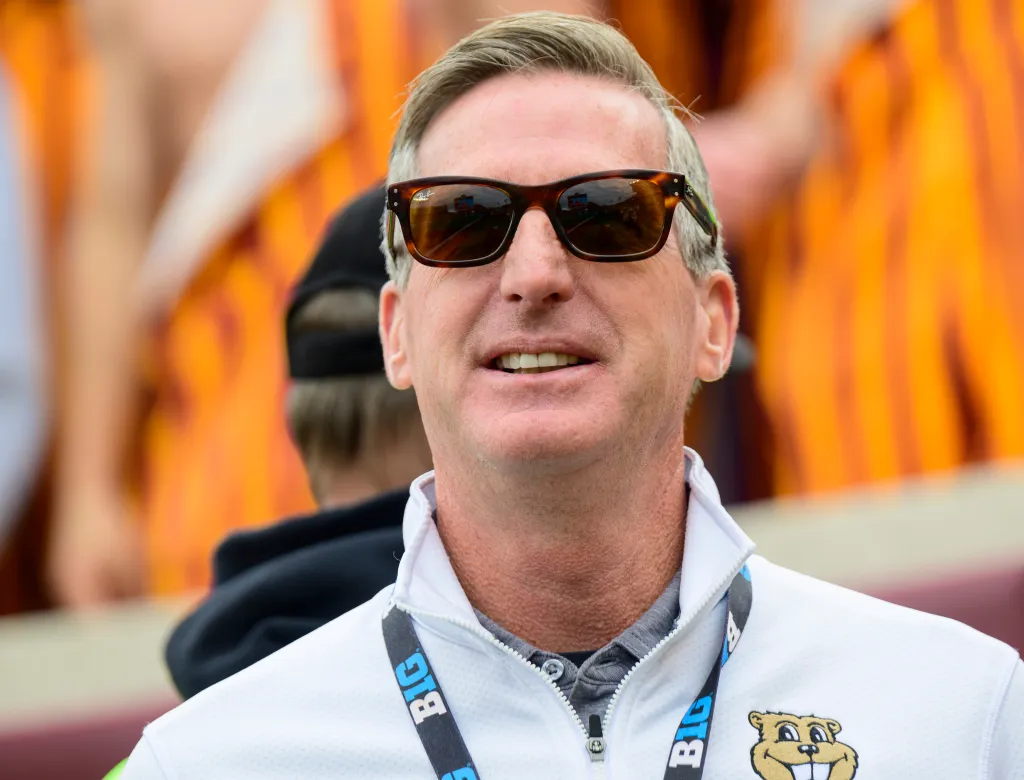
The first international game of the National Football League season, a Friday-night tilt between the Kansas City Chiefs and Los Angeles Chargers in São Paulo, is celebrated on the ground by the usual pomp and circumstance.
There are photo booths and merch tents catering to local fans, samba dancers in feathered head-pieces entertaining American die-hards traveling across the equator, and a press conference where Chiefs quarterback Patrick Mahomes has to backtrack after calling association football (that is, the kind that is still most popular in Brazil, and the rest of the word) “soccer.” But fans tuning in at home are greeted by a different, somewhat more disturbing spectacle: news that YouTuber, prolific content creator, and protein-infused milk impresario Jimmy “MrBeast” Donaldson has purchased the NFL.
In a pregame preview airing on YouTube–which, for the first time ever, is broadcasting a regular-season NFL game globally, and for free–the platform’s most valuable creator appears opposite league commissioner Roger Goodell, in a purportedly comical “sketch” about MrBeast’s takeover of the league, which sees him assigning popular content creators to team rosters. A postgame stunt sees Donaldson awarding one hardcore fan a ticket to Super Bowl LX, and firing another out of a human cannon. Not everyone welcomes the NFL’s new zillennial overlord. “MrBeast on my television invading my beautiful sport,” one fan posts on X. A friend (a lifelong football fan in his mid-40s) who texts me during the game says the whole production, “Looks insanely gen z.”
Which is of course the point. The September 5 YouTube-exclusive São Paulo game (the platform covered my travel expenses to attend), dovetails two of the NFL’s key priorities, spreading football both internationally and intergenerationally. “I completely understand that not all fans and audiences are going to welcome change,” Donaldson writes in a statement to WIRED. “Our hope is that over time they’ll recognize we are approaching everything we do with admiration and respect and want to be able to share something that’s as unique and special as the NFL with our fans.”
If the NFL fails to establish American football abroad, both with Gen Z—whose sports fandom, studies have shown, ranks the lowest among generational cohorts—and with international audiences unaccustomed to the distinctly American pastime, it won’t be for lack of trying. Since 2005, the league has been hosting regular-season games abroad. First was Mexico. Then London. Then Germany. Then Brazil. This season will see additional international games in Berlin, Madrid, and Dublin. The penetration into the South American market seems at once incredibly bold and completely sensible. Sensible, because players and fans alike don’t have to struggle against the pesky realities of time zones. And bold because, perhaps even more so than the UK or continental Europe, South America has its own distinct, passionate football culture that has nothing to do with its brawnier North American cousin.
The NFL’s 2025 Brazilian operation offers a good matchup for further testing the viability of the South American market. Due to their long, somewhat challenging, history in Southern California, the Chargers boast a substantial Latino fan base, who call them Los Bolts. And the Chiefs (despite being dismantled humiliatingly in last season’s Super Bowl) remain a global brand. The Chiefs have also benefited from the A-list celebrity of some of their players, specifically Mahomes, and tight end Travis Kelce, whose recent engagement to pop star Taylor Swift makes him de facto one of the most famous human beings on the planet. As James Brighton, a Chargers fan and California native who traveled to Brazil for the matchup, grumbles to me before the game, “Mahomes is easily marketable … Kelce and Taylor Swift is the romance the world wants to see, I guess. They’re the face of the NFL right now.” The league is counting on it. But for the NFL’s second Brazil game, they aren’t taking any chances.
“There is no better platform than YouTube,” says veteran broadcaster Rich Eisen, his head literally framed by a YouTube logo as he lounges in the YouTube-branded green room deep in the concrete bowels of São Paulo’s Neo Química Arena in the idle hours before he ascends to the broadcast booth to provide play-by-play commentary. “There is no more powerful distributor to reach people of all ages, and to feed an insatiable desire of people to take in content.”
Eisen speaks from experience. At 56, he may be a generation or three removed from the Gen Z–dominated domain of professional content creation. Nevertheless, he has been able to parlay his success as a journalist and longtime Sportscenter and NFL Network anchor into an arguably ever larger audience, streaming his Emmy-nominated, three-hour daily sports-talk program The Rich Eisen Show on YouTube, among other platforms. “The world has changed and you’ve got to be part of it,” he tells WIRED. “I mean, the commissioner of the NFL didn’t do a video about the Brazil game with me. And I’ve been his employee for 23 years! He did it with MrBeast.”
In an evolution of a partnership between the league and YouTube, the NFL has leveraged the video-sharing platform to package game highlights, clips, and weekly game previews.
To broadcast the game live from Brazil, YouTube ordered 100,000 pounds of production equipment, flown in on 11 cargo planes. “This is a Super Bowl–caliber production,” brags Adam Masterson, YouTube’s lead engineer overseeing the broadcast.
There’s no such thing as a “free” NFL game, of course. And YouTube’s brass are open about the experiment serving as a kind of “loss leader” (in retail terms) meant to drive interested viewers to the YouTube TV platform and the Sunday Ticket football package (which runs returning users $480 per season). “It’s an opportunity to really light up the platform, and our creators,” says Angela Courtin, YouTube’s vice president of brand marketing.
Those creators—several of whom have been flown in to participate in the broadcast and host streams before and during the game, along with local influencers—are essential to the YouTube-iness of the production.
Model and influencer haleyybaylee (aka Haley Kalil), who has 8 million YouTube subscribers, brings along her audience of “primarily young women.” She’s a Minnesota Vikings fan who used to watch games with her super-fan father, and her ex-husband, offensive tackle Matt Kalil, used to play for the team. Kalil cut her teeth producing what is sometimes (a little dismissively) called “WAG content,” representing the perspective of players’ “wives and girlfriends.” It’s a common pathway for fledgling female viewers wading into the sometimes intimidating pool of NFL fandom. “I got to learn football not only from my dad’s point-of-view, cursing at the screen, but also from a player’s point-of-view,” Kalil tells WIRED. “This isn’t a men’s sport. This is an everybody sport.”
Former college football player turned content creator Deestroying (real name Donald De La Haye), who has 6.3 million YouTube subscribers, joins YouTube’s production team—including seasoned broadcasters Eisen and Kay Adams, alongside former NFL quarterbacks turned commentators Kurt Warner and Cam Netwon—as the official “sideline creator.” Before kickoff, De La Haye says athletes have asked him for advice on making inroads in the streaming world. “More athletes are realizing they’re in control of the narrative,” he says. “They can make content. They could be more than just a football player.”
Enough current and former pros, including the Kelce brothers, have found second careers in podcasting, streaming, and content creation. And the NFL has long had its own presence on the platform, collecting highlights, analysis, and weekly game previews. For YouTube’s brass, making the move from aggregating NFL and NFL-related content to broadcasting an actual game felt like a natural, if ambitious, next step.
Christian Oestlien, who spearheads YouTubeTV’s expansion, cites an interesting stat. “Half of Gen Z has reported that they’d rather hear about a live event from their favourite creator than actually watch the event,” he says. “I interpret that as, ‘If I could watch a live event with my favorite creator, that would be the ideal.”
Broadcasters have already experimented with this format. Since 2021, ESPN has offered viewers the Manningcast: a feed that sees the famous sports brothers Eli and Peyton Manning reacting to games in real time. But it always seemed a little superfluous. It stands to reason that anyone who would tune in to watch the Mannings yammer over a game is already invested in the game in the first place. YouTube’s “Watch With” feeds cast the net a bit wider, luring in viewers who are fans of the creators first.
Of course, the league’s embrace of the creator class—its broader YouTube-ification—may reveal a deeper agenda, beyond juicing fandom among younger viewers. In August, the NFL announced that it was assuming a 10 percent equity stake in ESPN, the Disney-owned sports media network. The deal has already drawn criticism for its potential impact on journalists’ abilities to cover more critical stories, from colluding owners to concerns around players’ safety, sundry scandals, and off-field conduct. Streamers, TikTokkers, and YouTubers provide a form of journalism-adjacent “content” that seems more amenable to the league’s desire to protect, and even soften, its image.
By the end of the game—which sees the Chargers upset the Chiefs 27-21—YouTube’s first broadcast draws in some 17.3 million viewers, 1.1 million of whom were outside the United States. These are respectable numbers for the fledgling live sports broadcaster, putting the game about on par with the average viewership numbers of last season’s games—and drawing in a few million more viewers than last season’s Peacock-exclusive Friday night Brazil game. (The largest impediment to growing this number is likely not the platform, the match-up, or the location, but getting people habituated to stay in on Friday night and watch NFL football in prime time.) But in a way, the more compelling viewing narrative is unfolding away from second screens and Watch With streams, inside the Corinthians stadium itself.
Numbers provided by the NFL confirm that approximately 98 percent of tickets purchased for the Chiefs-Chargers title were purchased in Brazil. But American football still remains less popular there than professional basketball, volleyball, automobile racing, swimming, surfing, and capoeira—an Afro-Brazilian hybrid of marital artistry, dancing, and spiritual worship. And for all the talk of Brazilian fans’ passion and volume—hyped up by Chiefs players and head coach Andy Reid during the team’s press scrums—the actual crowd of 47,627 who roll out to the game at Neo Química Arena seems strangely muted. At least by the standards of frothing, howling, face-painted, beer-soaked, quasi-deranged football fandom that is the standard back in the US. Is it loud? Sure. But it’s not Lambeau Field or Arrowhead Stadium loud. Indeed, the unfurling of an enormous Brazilian flag during the national anthem, and the cameras spotting national soccer hero Neymar on the sidelines during the half-time show, merit the loudest, most unanimous roars.
Some moments seem a little lost-in-translation. Before the game, the enormous screens in the end zones project the rules of American football, outlining the diverse position groups and their respective skills. When he scores a 37-yard touchdown, Kelce celebrates by pretending to be a charging bull—oblivious, it would seem, to bullfighting being a Spanish and not Brazilian tradition.
And for all the talk of the NFL’s International Series doubling as a form of what the Washington Post editorial board recently termed American “soft power,” there is some friction there too. Audible boos ring out during the “Star Spangled Banner.” “They’re there in the first place,” the NFL’s Schroeder rationalizes, when asked about the crowd’s reaction. “So they’re clearly interested fans and excited to be a part of it all.”
Otherwise, fans don (mostly Chiefs) jerseys, cheer, and revel in the spectacle. But for the most part, fans approach the game like something of a novelty, greeted with a mix of enthusiasm, curiosity, and slight bafflement. A local I speak to before the game mentioned that in Brazil, American football is seen as a mainly middle- and upper-class preoccupation. Unlike soccer—the global popularity of which is at least partially attributable to it requiring little more than a ball—gridiron football demands specialized equipment, fields, and (most importantly) a working familiarity with its fairly byzantine rulebook. (There is only one Brazilian-born player currently rostered in the NFL: Chicago Bears kicker Cairo Santos.) The NFL and its partners are working devotedly to alleviate the familiarity hurdle, building out a broadcast landscape to juice the appeal of a sport that is thrillingly intense, endlessly deep, and quintessentially American. Lowering the barriers to entry to make the game not just watchable, but actually accessible, will be the next big leap in the NFL’s ongoing mission to globalize the league, and redefine how the world thinks of the word “football.”
Racked in one of the many enormous merch kiosks on-site is a commemorative T-shirt depicting a young Brazilian boy standing in a run-down favela, gripping an oblong football, and donning a helmet emblazoned with a Chiefs arrowhead on one side and the arcing Chargers bolt on the other. I almost consider buying it as a souvenir, if only because its impressionistic image seemed so completely absurd—and so obviously aspirational, albeit not in the way that’s likely intended. It’s not about the fantasies of some hypothetical little kid of some new generation, nurturing his gridiron dreams in a land far away from the fatherland of Cowboys and Chiefs and Eagles and Niners. It’s about the NFL’s dream, and dogged determination, to create him.



